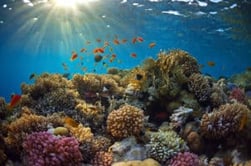5 High-Quality Characteristics to Consider When Using Natural Phenomena in Your Science Classes
We've all seen that blank stare on students' faces whenever you're teaching an abstract science concept like atoms or cells. They are either thinking to themselves, "Why does this matter to me?", or "I wonder what's for lunch today?"
A teacher's job is difficult enough as is. Using natural phenomena to introduce a science concept is a research-based method to increase student engagement throughout the entire lesson.
I've put together a list of 5 characteristics of natural phenomena for your science class.
- A good natural phenomenon has an explanation that is more complex than can be answered in a quick Google search. The initial phenomenon typically leads to more questions rather than a single answer. For example, you could show a video about killer whales working together to find food. This one example should uncover dozens of questions about ecosystems. How do the organisms work together? What are the differences between predator and prey? What makes something biotic or abiotic? Do organism interactions play a larger role in the ecosystem? Are these interactions found in all ecosystems?
- Phenomena are built on experiences which students may already have some context of. The old saying goes, 'meet students where they are at.' This is true of phenomena as well. Your students likely come from diverse backgrounds. It's important to keep that in mind when choosing a phenomenon to introduce a science concept. It's your job to bridge the gap between existing knowledge and new content.
- Great phenomena include the overall impact on the community and stakeholder. A student is going to be much more engaged in the lesson if they can relate it back to their own community. The example of the killer whales above may not have the same impact on a student in Florida as one from the Pacific Northwest. A Florida teacher can easily adapt the phenomenon to a regional predator like the American alligator.
- Phenomena could be a case study (ex. Why has the bat population in North America decreased over the last few decades) or simply a sense of wonder (Why does the moon look different each night?). Each of these formats allows the students to become invested in the science topic.
- Phenomena which include a range of multimedia will have a greater impact than a text-based approach. Videos, animated gifs, infographics, interactive simulations, or hands-on discrepant events are all great ways to engage students at the beginning of a unit.
It's likely that one of your greatest challenges is trying to find good phenomena introductions for your class. I've put together a list of a few of high-quality resources where you can begin your search.
- #Project Phenomena - https://sites.google.com/site/sciencephenomena/ - searchable database of phenomena, NGSS aligned, great descriptions and suggested uses
- NGSS Phenomena - https://www.ngssphenomena.com/ - searchable database of phenomena, includes some animated .gifs but are lacking in their descriptions
- 25 Cool Natural Phenomena - http://www.businessinsider.com/25-of-the-coolest-natural-phenomena-2016-6/#1-volcanic-lightning-1 - This list isn't searchable, but there are some really cool natural phenomena listed here.
- Teacher Curated List - https://docs.google.com/document/d/1UOJFhs7zd0R__CYSSPRSFRDv2Z42Yww0JBdhZ7TbU8o - This list was curated by teachers in the Kesler Science Facebook Group.
Other Resources:
NGSS document - Using phenomena in NGSS lessons
Download Over $100 in FREE Resources
For Middle School Science
Simply create a login below and gain immediate access to a selection of our Kesler Science product line worth $100 - for FREE. There's a full version of every product type! You'll also join tens of thousands of middle school science teachers who receive timely tips and strategies straight to their inbox.




